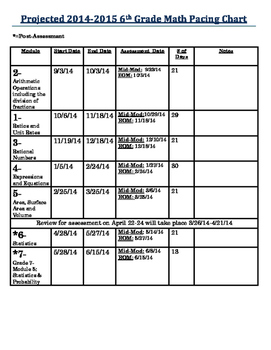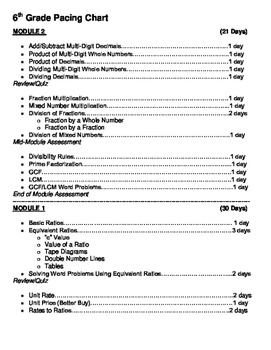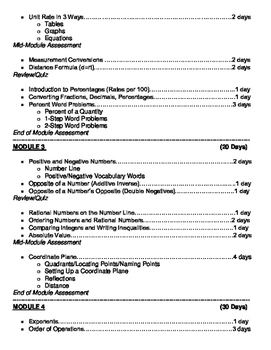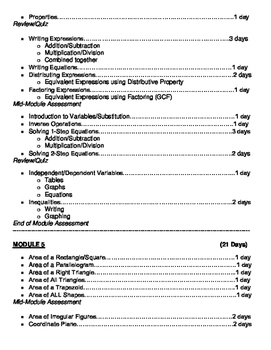Math Mods
108 Followers
Grade Levels
6th
Subjects
Resource Type
Standards
CCSS6.G.A.1
CCSS6.G.A.2
CCSS6.G.A.3
CCSS6.G.A.4
CCSS6.SP.A.1
Formats Included
- PDF
Pages
5 pages
Math Mods
108 Followers
Description
The projected scope and sequence provides a daily break down of the topics to be taught in the 6th grade. This scope and sequence is broken down in accordance with New York State Common Core Standards. Included is a pacing guide for the year. Descriptions include topics and daily allotted time to assure complete instruction before state assessments (April) and final exams (June). I have a lesson for each topic listed in the scope and sequence located below. Click to open.
Back to School Activities (Week 1):
What Kind of Learner Are You? Learning Modalities Survey
What Pokemon Are You? Interactive Personality Survey
Ice Breaker Card Activity
6th Grade Math Vocabulary List
Module 2: Arithmetic Operations
Add and Subtract Decimals
Multiplying Decimals
Dividing Decimals with Decimal Divisors
Decimal Operations Review and 2 Quizzes
Dividing two and three digit divisors
Adding and Subtracting Fractions
Adding and Subtracting Mixed Numbers
Multiplying Fractions and Mixed Numbers
Dividing Fractions and Dividing Whole Numbers and Fractions
Operations with Fractions Quiz and Practice Review Quiz
Divisibility Rules and Prime Factorization
GCF (Greatest Common Factor) and LCM (Least Common Multiple)
Module 2 Test and Review (Arithmetic Operations)
Module 1: Ratios and Proportions
Introduction to Ratios
Equivalent Ratios
Ratio Tables and Proportions
Tape Diagrams
Tape Diagrams Halloween
Graphing Linear Relationships (Ratios)
Mid Module 1 Exam (Ratios and Proportions)
Converting Measurements Using Proportions
Comparing Using Unit Rate
Problem Solving Using Rates
Unit Rate and the Distance Formula
Introduction to Percents
Percent and Rates per 100
Percent of a Number
Calculating Tax, Tip and Discount
End of Module 1 Test (Ratios and Proportions)
Module 3: Rational Numbers
Integers and the Number Line
Integer Real World Vocabulary
Comparing and Ordering Integers
Introduction to Graphing Quadrant 1
Graphing Polygons in the Coordinate Plane
Distances in the Coordinate Plane
Graphing in the Coordinate Plane (4 Quadrants)
Problem Solving in the Coordinate Plane
Graphing Symmetry in the Coordinate Plane
Module 3 Test and Review (Rational Numbers)
Module 4: Expressions and Equations
Exponential Notation
Order of Operations Day 1
Order of Operations Day 2
Properties of Real Numbers
Flip Chart Activity Properties of Real Numbers
Properties of Real Numbers Day 2
Evaluating Algebraic Expressions
Writing Algebraic Expressions
Introduction to Distributive Property
Solving One-Step Equations (Addition and Subtraction)
Solving One-Step Equations (Multiplication and Division)
Solving Two-Step Equations
Graphing Inequalities
Solving Inequalities
Graphing Linear Equations
Module 4 Test and Review (Expressions and Equations)
Module 5: Geometry
Perimeter of Polygons
Area and Perimeter of Polygons
Area of Rectangles
Area of Parallelograms and Triangles
Introduction to Prisms and Pyramids
Volume of Rectangular Prisms
Polygons in the Coordinate Plane
Drawing Nets
Surface Area of Solids
Module 5 Test (Geometry)
State Test Review:
Day 1: Numeration
Day 2: Algebra
Day 3: Ratios and Proportions
Day 4: Fractions
Module 6: Statistics and Probability
Introduction to Charts and Graphs
Line Plots
Analyzing Line Plots
Shapes of Distribution
Frequency Tables and Histograms
Statistics Quiz 1
Measures of Central Tendency
Mean Absolute Deviation (MAD)
Stem and Leaf Plots
Box Plots (Box and Whisker)
Statistics Review and Quiz
Statistics Project
Module 6 Test (Statistics)
End of Year:
Final Exam Review Packet
Final Exam
Summer Packet Assignment
Back to School Activities (Week 1):
What Kind of Learner Are You? Learning Modalities Survey
What Pokemon Are You? Interactive Personality Survey
Ice Breaker Card Activity
6th Grade Math Vocabulary List
Module 2: Arithmetic Operations
Add and Subtract Decimals
Multiplying Decimals
Dividing Decimals with Decimal Divisors
Decimal Operations Review and 2 Quizzes
Dividing two and three digit divisors
Adding and Subtracting Fractions
Adding and Subtracting Mixed Numbers
Multiplying Fractions and Mixed Numbers
Dividing Fractions and Dividing Whole Numbers and Fractions
Operations with Fractions Quiz and Practice Review Quiz
Divisibility Rules and Prime Factorization
GCF (Greatest Common Factor) and LCM (Least Common Multiple)
Module 2 Test and Review (Arithmetic Operations)
Module 1: Ratios and Proportions
Introduction to Ratios
Equivalent Ratios
Ratio Tables and Proportions
Tape Diagrams
Tape Diagrams Halloween
Graphing Linear Relationships (Ratios)
Mid Module 1 Exam (Ratios and Proportions)
Converting Measurements Using Proportions
Comparing Using Unit Rate
Problem Solving Using Rates
Unit Rate and the Distance Formula
Introduction to Percents
Percent and Rates per 100
Percent of a Number
Calculating Tax, Tip and Discount
End of Module 1 Test (Ratios and Proportions)
Module 3: Rational Numbers
Integers and the Number Line
Integer Real World Vocabulary
Comparing and Ordering Integers
Introduction to Graphing Quadrant 1
Graphing Polygons in the Coordinate Plane
Distances in the Coordinate Plane
Graphing in the Coordinate Plane (4 Quadrants)
Problem Solving in the Coordinate Plane
Graphing Symmetry in the Coordinate Plane
Module 3 Test and Review (Rational Numbers)
Module 4: Expressions and Equations
Exponential Notation
Order of Operations Day 1
Order of Operations Day 2
Properties of Real Numbers
Flip Chart Activity Properties of Real Numbers
Properties of Real Numbers Day 2
Evaluating Algebraic Expressions
Writing Algebraic Expressions
Introduction to Distributive Property
Solving One-Step Equations (Addition and Subtraction)
Solving One-Step Equations (Multiplication and Division)
Solving Two-Step Equations
Graphing Inequalities
Solving Inequalities
Graphing Linear Equations
Module 4 Test and Review (Expressions and Equations)
Module 5: Geometry
Perimeter of Polygons
Area and Perimeter of Polygons
Area of Rectangles
Area of Parallelograms and Triangles
Introduction to Prisms and Pyramids
Volume of Rectangular Prisms
Polygons in the Coordinate Plane
Drawing Nets
Surface Area of Solids
Module 5 Test (Geometry)
State Test Review:
Day 1: Numeration
Day 2: Algebra
Day 3: Ratios and Proportions
Day 4: Fractions
Module 6: Statistics and Probability
Introduction to Charts and Graphs
Line Plots
Analyzing Line Plots
Shapes of Distribution
Frequency Tables and Histograms
Statistics Quiz 1
Measures of Central Tendency
Mean Absolute Deviation (MAD)
Stem and Leaf Plots
Box Plots (Box and Whisker)
Statistics Review and Quiz
Statistics Project
Module 6 Test (Statistics)
End of Year:
Final Exam Review Packet
Final Exam
Summer Packet Assignment
Total Pages
5 pages
Answer Key
Does not apply
Teaching Duration
1 Year
Report this resource to TPT
Reported resources will be reviewed by our team. Report this resource to let us know if this resource violates TPT’s content guidelines.
Standards
to see state-specific standards (only available in the US).
CCSS6.G.A.1
Find the area of right triangles, other triangles, special quadrilaterals, and polygons by composing into rectangles or decomposing into triangles and other shapes; apply these techniques in the context of solving real-world and mathematical problems.
CCSS6.G.A.2
Find the volume of a right rectangular prism with fractional edge lengths by packing it with unit cubes of the appropriate unit fraction edge lengths, and show that the volume is the same as would be found by multiplying the edge lengths of the prism. Apply the formulas 𝘝 = 𝘭 𝘸 𝘩 and 𝘝 = 𝘣 𝘩 to find volumes of right rectangular prisms with fractional edge lengths in the context of solving real-world and mathematical problems.
CCSS6.G.A.3
Draw polygons in the coordinate plane given coordinates for the vertices; use coordinates to find the length of a side joining points with the same first coordinate or the same second coordinate. Apply these techniques in the context of solving real-world and mathematical problems.
CCSS6.G.A.4
Represent three-dimensional figures using nets made up of rectangles and triangles, and use the nets to find the surface area of these figures. Apply these techniques in the context of solving real-world and mathematical problems.
CCSS6.SP.A.1
Recognize a statistical question as one that anticipates variability in the data related to the question and accounts for it in the answers. For example, “How old am I?” is not a statistical question, but “How old are the students in my school?” is a statistical question because one anticipates variability in students’ ages.





